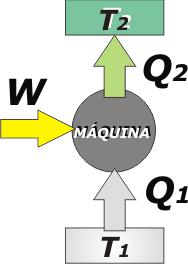 |
NO ME SALEN
(APUNTES TEÓRICOS DE BIOFÍSICA DEL CBC)
MAQUINAS FRIGORIFICAS
|
|

|
| |
Chillers (refrigeration machines)
Below, we have the typical scheme of a chiller (which is also thermal machine) working at a constant rate (without varying its own temperature), and therefore keeping its internal energy constant, ΔU = 0. I 'm going to user the typical example of a fridge. |
| |
 |
The elements of the scheme are:
|
- the cold source, represented with a white rectangle (which could be the inside of a fridge, where the you put the food). The temperature of the source is T1;
|
- the hot source, represented with a green rectangle (which could be the environment). The temperature of the hot source is T2, with T1 < T2, logically;
|
- the machine itself, which usually operates cyclically;
|
- the three arrows, which are: Q1, the heat taken from the cold source; Q2, the heat expelled to the environment; and L, the work done over the machine (usually an electric motor that is right next to the machine).
|
|
|
|
Of course, every chiller must blindly fulfill the first principle of thermodynamics: Q1 - Q2 = W. Notice that here the work must be negative because the machine receives it (everyone knows that the fridge does not work if it is not plugged in) so then, you could to conclude that the refrigerating machine heats more than what it cools.
Coefficient of performance (thermal efficiency)
The concept of performance in thermodynamics, e, it’s the same as thermal efficiency (conceptually) and has no different meaning from the one in colloquial language. A machine (like a business) yields the higher the benefit and the lower the cost or the investment. In the case of the chiller, the benefit is the heat extracted from the cold source (the inside of a fridge, the air-conditioned room, or whatever) and the investment is the work of the electric motor that we plug in (then, we'll have to pay the electricity bill). |
|
Both W and L are ways to symbolize
work |
|
| |
e = Q1 / W |
thermal efficiency |
|
|
|
As is easy to deduct from the definition, the coefficient of performance –same as efficiency- is a number, so it has no units. It is customary to present it in percentage. |
|
|
NOTE: in books, the codes, positions and subscripts for the schematic elements of the thermal machine vary widely. It is very common to use C for hot source (instead of 1) and F for cold source (instead of 2); same for the heats. The positions - up or down - of the sources also varies. |
|
|
|
| |
|
Curious Facts |
|
|
- The Second Law of Thermodynamics can be used to calculate maximum efficiency, eM, which depends on the outside and inside temperature of the chiller, and is equal to:
|
|
 |
|
|
- The efficiency of fridge is around 4, while the maximum efficiency (given by the 2nd law) is around 16.
|
|
Captious Questions |
|
- Does it make sense to open the fridge to cool the kitchen?
- What is the use of that black lattice in the back of the fridge? (And do not answer that to gather dirt because. although that is true. you know it is for something else).
|
|
| |
| |
|
|
| Some rights reserved. Reproduction permitted if quoting the source. Last updated on Jan-17.Translated by Esteban Djeordjian. Buenos Aires, Argentina. |
|
|
 |
| | |
|
|

